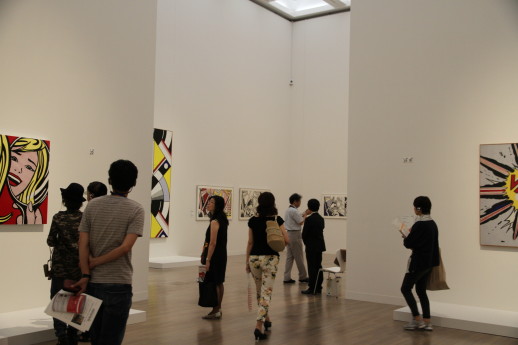The Powers of Pop Art
One of the most comprehensive exhibitions of American pop art ever to be seen in Japan, “American Pop Art: From the John and Kimiko Powers Collection” opened recently in Tokyo. American pop art was a reaction to mass production and consumption, and the explosion of popular culture in post-WWII America. John and Kimiko Powers started collecting art in the 1960s (predominantly traditional Japanese scrolls and American pop art), and though John passed away in 1999, Kimiko has continued to carry on in their pursuits, splitting her time between Japan and Colorado, USA. With Japan’s unique connection to American pop culture—via the post-war American occupation—and Kimiko’s intrinsic connection to Japan, it is fitting that this comprehensive display of the Powers’ extensive pop art collection has opened in Tokyo before anywhere else.
For its part, the National Art Center has displayed the work with expected proficiency. Prints, paintings, drawings, and sculptures are tastefully arranged, segregated into rooms dedicated to individual artists or thematic groupings. The first section includes work by pop art godfather Robert Rauschenberg, whose lithographs bridge abstract expressionism and the “new realism” Warhol and his ilk would establish by 1962. Most interesting are Rauschenberg’s interactive works, such as Broadcast (1959), a mixed media painting, which includes dials protruding through the canvas from three once-functioning radios mounted behind the surface; and an impressively large, motorized sculpture, Revolver (1967), featuring five motorized Plexiglas discs with screen-printed imagery, mounted in an aluminum cradle where, by pressing control buttons, each disc can be rotated individually, creating virtually limitless montages of superimposed images. Inevitably, the works are given true museum treatment: viewers are prohibited from touching, let alone engaging the original functionality of these works.

Next are selections from a vast stock of Jasper Johns’s work. The Powers have collected so much of Johns’s work that Kimiko recently opened the Powers Art Center in Colorado, “dedicated to the study, display, and dissemination of prints by Jasper Johns.”
Claes Oldenburg is also featured individually, represented in numerous drawings, notes and sculptures. His Giant Soft Drum Set (1967) is an over-sized vinyl drum kit that has had all its rigidity removed, leaving a molting, sagging pile of boneless drum flesh. The sculpture is elevated even higher than the substantial plinth on which it is mounted by revealing the creative process behind it: draftsman-like studies of individual sections of a drum set and its various parts, along with concept art for the sculpture itself.
One of the most charming aspects of the Powers’ collection is the evidence of personal relationships they’ve had with the artists. In the “Artists as Friends” section, viewers can get a glimpse of small, personal mementos addressed to the Powers by several of the “stars” of this show, including, among others, a valentine message from Oldenburg and an autographed poster from a 1981 Andy Warhol show at Colorado State University, signed: “To John and Kimiko. Love, Andy.”
The next few rooms are adorned with large-scale displays of Warhol’s work, including mostly silkscreened multiples arranged in aesthetically pleasing ways. One room is dedicated entirely to several screen-printed series of Kimiko Powers ranging from 1972-83. It’s easy to feel star struck here and throughout the exhibit when encountering seminal works by Warhol, Roy Lichtenstein, Mel Ramos, Tom Wesselmann, et al. We’ve seen so many reproductions of this pop art in pop culture, and that goes especially for generations of art history majors who have read and written about the significance of these artists and their oeuvres. However, an encounter with celebrity can sometimes be a let down: up close, wrinkles, small stature, or other disappointments are revealed. So too is the realization that Warhol’s attempts at removing the artist’s hand in favor of machine-like reproduction sometimes fell short. Undoubtedly he proved his point that anyone can create “art” and gain celebrity with his silkscreened multiples; these were neither difficult churn out nor terribly considered as individual objects d’art, but rather products of a mechanical process often carried out by hired hands. Ultimately, these works have become decorative silkscreens applied to still other surfaces: shopping bags, mugs, etc.—some of which are for sale in the museum gift shop. One work that stands apart is this exhibit’s centerpiece is 200 Campbell’s Soup Cans (1962), which was actually carried out by Warhol’s own hand (at least more directly than later works) in an early attempt to achieve what he later described as “anonymity” in art making (this is ironic considering how this work would become such a signature piece). Yet his hand betrayed this with some minor deviations in proportion and registration. Perhaps it is this evidence of Warhol’s fallibility with spray paint, stencil, and pencil that makes it such a draw to see in person. Sometimes witnessing celebrities’ humanity, warts and all, can endear them to us even more.
Pop art persists and continues to re-contextualize mass culture, building on what Duchamp and the Dadaists began with their “readymade” art almost a century ago. If you visit the museum, you can even get your own readymade, commemorative pop art piece in the gift shop. Images reproduced on wearable and collectable objects and the celebration of kitsch are all still part of contemporary pop—and museum—culture. As I walked through said gift shop, I found a stack of what appeared to be cans of Campbell’s soup for sale. This reminded me of another pop art progenitor, René Magritte (This is Not a Pipe), as I wondered, “Is this soup?” Realizing I was allowed to touch them, I picked one up, and, yes, they were actual cans of Campbell’s soup. Thanks to Warhol, and the patronage of John and Kimiko Powers, that iconic label design is unlikely to change anytime soon.
Matt Wyatt
Matt Wyatt


